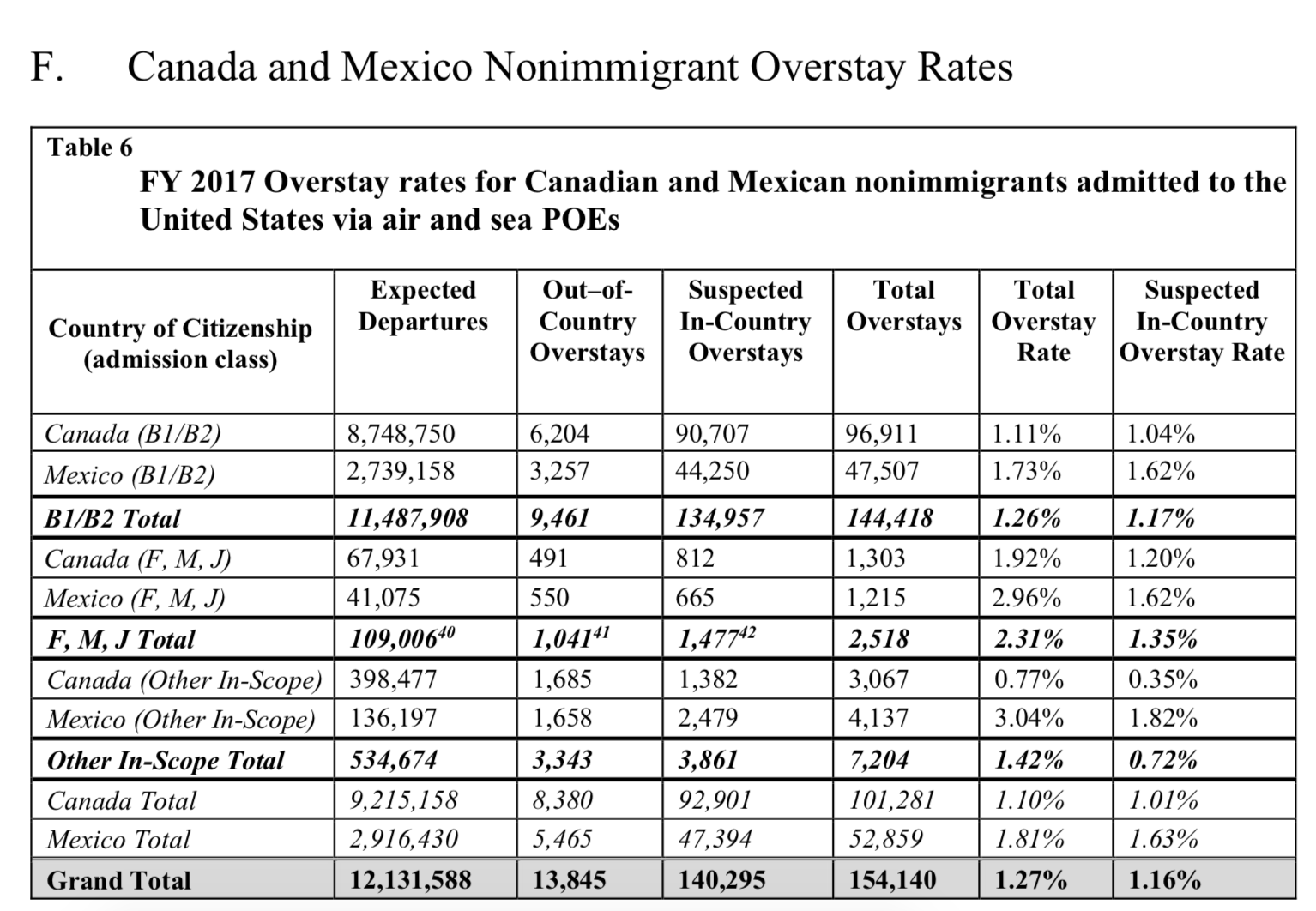The following media release below was shared by the U.S. Department of Homeland Security (DHS) on Tuesday afternoon. It goes into detail about its 2017 Entry/Exit Overstay Report. At one point in the release, DHS states that it “calculated a total overstay rate of 1.33 percent, or 701,900 overstay events.”
The DHS report also noted who is overstaying their visas via land and sir. Looks like it’s Canada. As the DHS release states, “the FY 2017 Suspected In-Country Overstay rate for those traveling through air and sea POEs is 1.01 percent of 9,215,158 expected departures. For Mexico, the FY 2017 Suspected In-Country Overstay rate for those traveling through air and sea POEs is 1.63 percent of 2,916,430 expected departures.”
In other words, 101,281 Canadians overstayed their visas in 2017, when compared to just 52,589 Mexicans. And if you look at the whole report, Canada is the top country (about 14%) with the most visa overstays.


DHS did explain that “this represents only travel through air and sea POEs [Ports of Entry] and does not include data on land border crossings. DHS is currently working to improve its monitoring capability for land POEs.”
Ok.
But still.
Oh, Canada.
***
Here is the full release:
WASHINGTON — The U.S. Department of Homeland Security (DHS) today released the Fiscal Year (FY) 2017 Entry/Exit Overstay Report. The report provides data on departures and overstays, by country, for foreign visitors to the United States who entered as nonimmigrants through an air or sea Port of Entry (POE) and were expected to depart in FY 2017. The in-scope population for this report includes temporary workers and families, students, exchange visitors, temporary visitors for pleasure, temporary visitors for business, and other nonimmigrant classes of admission.
DHS has determined that there were 52,656,022 in-scope nonimmigrant admissions to the United States through air or sea POEs with expected departures occurring in FY 2017; the in-scope admissions represent the vast majority of all air and sea nonimmigrant admissions. Of this number, DHS calculated a total overstay rate of 1.33 percent, or 701,900 overstay events.The report also breaks down the overstay rates further to provide a better picture of those overstays who remain in the United States beyond their period of admission and for whom there is no identifiable evidence of a departure, an extension of period of admission, or transition to another immigration status. At the end of FY 2017, there were 606,926 Suspected In-Country Overstays. The overall Suspected In-Country Overstay rate was 1.15 percent of the expected departures. The U.S. government is using a multifaceted approach to enforce overstay violations, including improving entry and exit data collection and reporting, notifying visitors of an impending expiration of their authorized period of admission, cancelling travel authorizations and visas for violators, recurrent vetting of many nonimmigrants, and apprehending overstays present in the United States.
A further breakdown can be found below and the full report is available here.
Visa Waiver Program (VWP) Country Overstay Rate
This report separates Visa Waiver Program (VWP) country overstay figures from non—VWP country figures. For VWP countries, the FY 2017 Suspected In-Country Overstay rate was 0.51 percent of the 22,472,710 expected departures.
Non-Visa Waiver Program Participant Overstay Rate
For non-VWP countries, the FY 2017 Suspected In-Country Overstay rate is 1.91 percent of the 14,659,249 expected departures.
Student or Exchange Visitor Visa Overstay Rate
For nonimmigrants who entered on a student or exchange visitor visa (F, M, or J visa), DHS has determined there were 1,662,369 students and exchange visitors scheduled to complete their program in the United States. However, 4.15 percent stayed beyond the authorized window for departure at the end of their program.
Canada and Mexico Overstay Rates
Unlike other countries, a majority of travelers from Canada and Mexico enter the United States by land. Figures pertaining to Canada and Mexico are presented separately from the other countries due to the fact that air and sea information represent a much smaller portion of the Canadian and Mexican travel population. For Canada, the FY 2017 Suspected In-Country Overstay rate for those traveling through air and sea POEs is 1.01 percent of 9,215,158 expected departures. For Mexico, the FY 2017 Suspected In-Country Overstay rate for those traveling through air and sea POEs is 1.63 percent of 2,916,430 expected departures. This represents only travel through air and sea POEs and does not include data on land border crossings. DHS is currently working to improve its monitoring capability for land POEs.


